Seafood enchiladas are a delightful fusion of coastal flavors and traditional Mexican cuisine. Whether you’re a seasoned cook or a novice in the kitchen, mastering this recipe opens the door to a world of culinary possibilities. This guide is designed to take you step-by-step through the process, ensuring you achieve the perfect balance of creamy, cheesy, and seafood-rich enchiladas every time.
Table of Contents
What Are Seafood Enchiladas?
Seafood enchiladas are a variation of the classic enchilada, which consists of tortillas filled with a variety of ingredients and covered in a flavorful sauce. In this seafood twist, the filling typically includes shrimp, crab, fish, or a combination of these, often enhanced with spices, vegetables, and a creamy sauce. These enchiladas are then rolled, topped with more sauce and cheese, and baked to golden perfection.
The allure of seafood enchiladas lies in their ability to combine the delicate flavors of seafood with the robust and comforting elements of traditional Mexican cooking. They can be customized with different types of seafood and sauces, from tangy tomatillo to rich, creamy white sauce.
Essential Ingredients for Seafood Enchiladas
List of Ingredients
Here’s a basic list of ingredients needed to make seafood enchiladas, with approximate quantities for serving 4-6 people:
- Tortillas (8-10 medium-sized, flour or corn)
- Seafood:
- Shrimp: 1 pound, peeled and deveined
- Crab meat: 8 ounces, fresh or canned
- Optional: 1 cup of cooked, flaky white fish (e.g., cod or tilapia)
- Cheese:
- Shredded Monterey Jack or Cheddar: 2 cups
- Optional: ½ cup of crumbled queso fresco for garnish
- Creamy Sauce:
- Heavy cream: 1 cup
- Sour cream: ½ cup
- Butter: 2 tablespoons
- All-purpose flour: 2 tablespoons
- Chicken or vegetable broth: 1½ cups
- Green chilies: 1 small can, diced
- Garlic: 2 cloves, minced
- Onion: 1 small, finely chopped
- Seasonings:
- Cumin: 1 teaspoon
- Paprika: 1 teaspoon
- Salt and pepper: to taste
- Garnishes:
- Fresh cilantro: 2 tablespoons, chopped
- Lime wedges: for serving
Choosing the Right Seafood for Enchiladas
The seafood is the star of this dish, so choosing high-quality, fresh ingredients is key:
- Shrimp: Look for medium-sized shrimp that are firm and smell fresh (avoid any ammonia odor). Frozen shrimp can work well, but make sure they are fully thawed before use.
- Crab Meat: Opt for fresh crab meat from the seafood counter or high-quality canned varieties labeled as lump or claw meat. Ensure no shell fragments remain.
- Fish: If including fish, choose a mild white fish like cod, tilapia, or halibut. These varieties hold up well during cooking and won’t overpower the dish’s flavors.
When possible, purchase sustainable seafood to support eco-friendly practices and enjoy the freshest flavors.
Alternative Ingredients for Dietary Restrictions
Accommodating dietary preferences or restrictions doesn’t mean sacrificing flavor. Here are some substitutions to make your seafood enchiladas inclusive:
- Gluten-Free: Use corn tortillas instead of flour and substitute gluten-free flour in the sauce.
- Dairy-Free: Replace cheese with dairy-free cheese alternatives, and use coconut milk or cashew cream for the sauce.
- Vegetarian: Swap seafood for roasted vegetables such as zucchini, mushrooms, and bell peppers, or use plant-based seafood alternatives.
- Low-Carb: Use low-carb tortillas or wrap the filling in large lettuce leaves for a lighter option.
- Allergy-Friendly: For those allergic to shellfish, stick to fish or plant-based alternatives.
With the right ingredients and substitutions, seafood enchiladas can be tailored to any taste or dietary need while retaining their creamy, savory charm.
Step-by-Step Cooking Guide
Follow these steps to create delicious seafood enchiladas with ease and confidence.
Preparing the Seafood
- Shrimp:
- Rinse the shrimp under cold water, peel, devein, and pat dry.
- Heat a skillet over medium heat with 1 tablespoon of olive oil. Sauté shrimp for 2-3 minutes on each side until pink and opaque. Remove from heat and chop into bite-sized pieces.
- Crab Meat:
- If using fresh crab, ensure all shells are removed.
- If using canned crab, rinse and drain it thoroughly.
- Fish (Optional):
- Season a mild white fish with salt, pepper, and a pinch of paprika.
- Cook in the same skillet used for the shrimp, about 3-4 minutes per side, until flaky. Break into pieces with a fork.
Combine the seafood in a bowl and set aside.
Making the Enchilada Sauce
- In a medium saucepan, melt 2 tablespoons of butter over medium heat.
- Add 2 tablespoons of flour and whisk to form a roux. Cook for 1 minute until golden.
- Gradually pour in 1½ cups of chicken or vegetable broth, whisking constantly to avoid lumps.
- Stir in 1 cup of heavy cream, ½ cup of sour cream, and a can of diced green chilies.
- Add minced garlic, onion, cumin, paprika, salt, and pepper. Simmer for 5 minutes until the sauce thickens.
- Taste and adjust seasoning as needed.
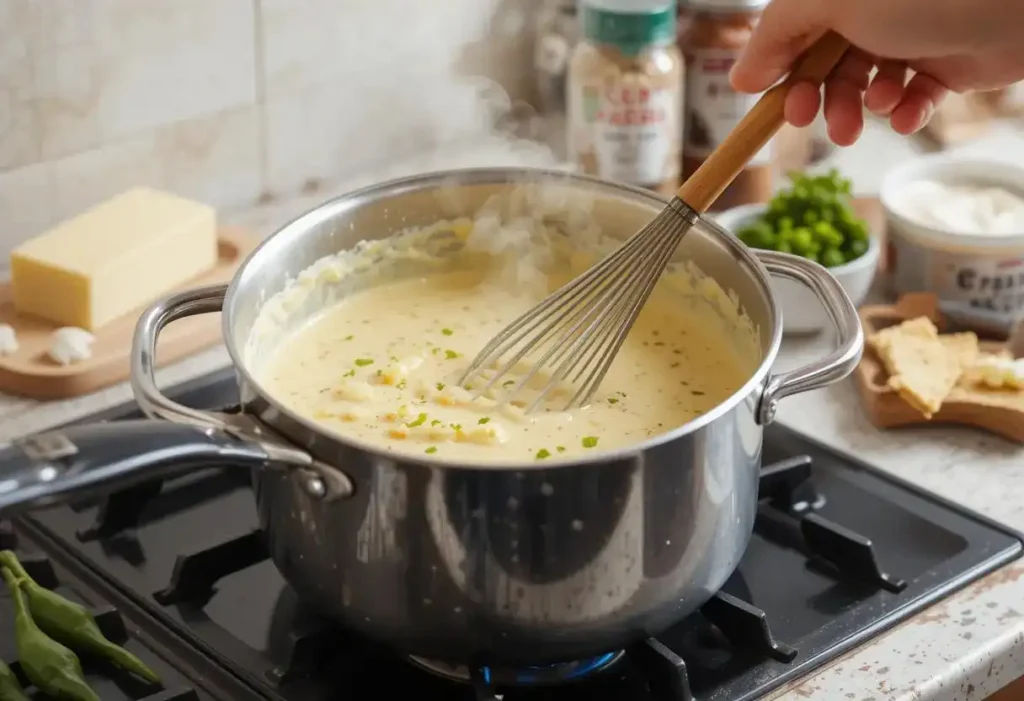
Assembling the Enchiladas
- Preheat your oven to 375°F (190°C).
- Lightly grease a large baking dish.
- Lay a tortilla flat on a clean surface. Spread a thin layer of sauce in the center.
- Add a scoop of the seafood mixture and a sprinkle of shredded cheese.
- Roll the tortilla tightly and place it seam-side down in the prepared dish. Repeat with the remaining tortillas and filling.
- Pour the sauce generously over the rolled tortillas, ensuring they are fully covered.
- Top with the remaining shredded cheese.
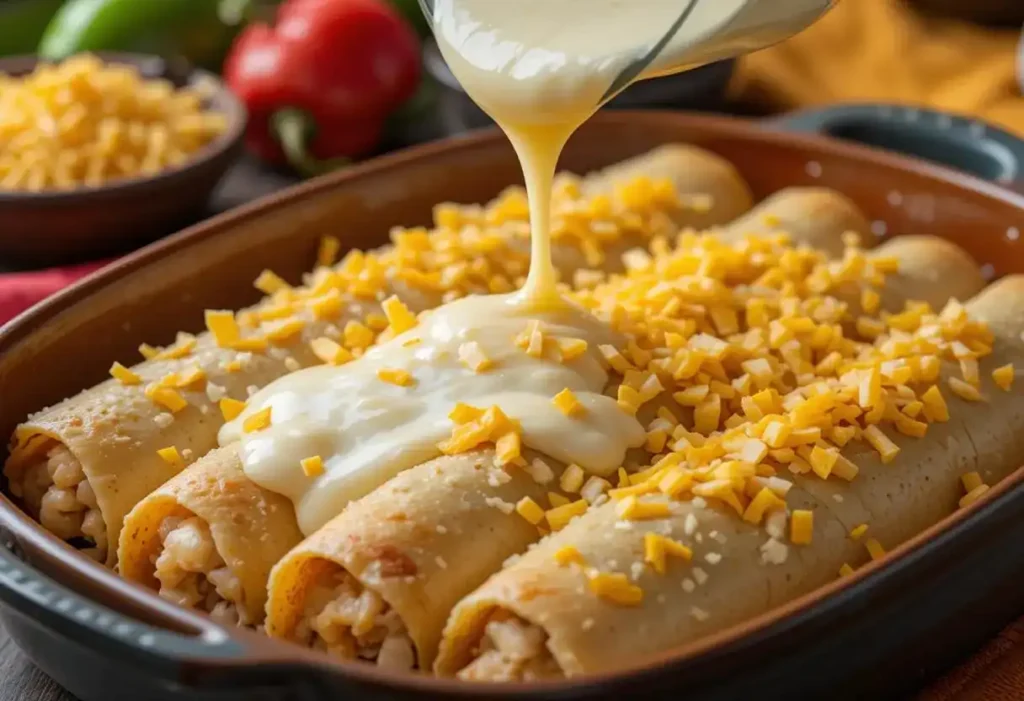
Baking Instructions
- Cover the baking dish with aluminum foil and bake in the preheated oven for 20 minutes.
- Remove the foil and bake for an additional 10-15 minutes, or until the cheese is melted and bubbly.
- Remove from the oven and let cool for 5 minutes.
- Garnish with fresh cilantro and serve with lime wedges.
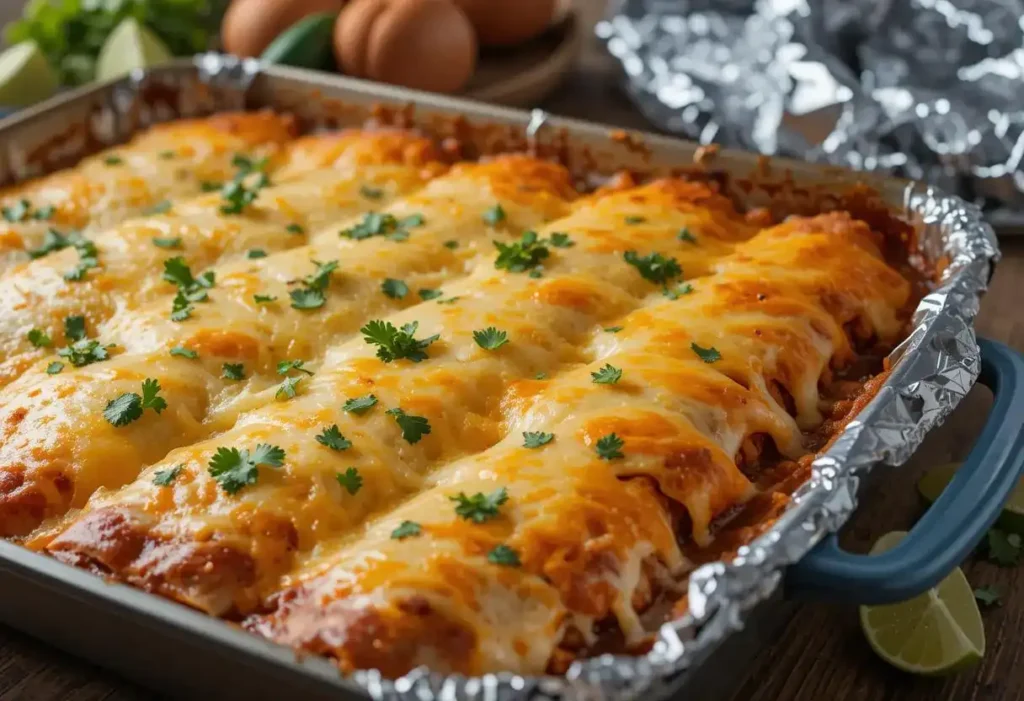
Cooking Tips and Techniques
Tips for Perfect Enchiladas Every Time
- Warm Tortillas: Warm tortillas before filling to make them pliable and prevent tearing.
- Even Sauce Distribution: Spread a thin layer of sauce on the bottom of the baking dish to prevent sticking.
- Don’t Overfill: Use just enough filling to roll the tortilla snugly without it bursting.
- Layer the Cheese: Ensure a cheesy top layer for a golden, bubbly finish.
- Rest Before Serving: Let the enchiladas rest for a few minutes after baking to set and enhance flavor.
Common Mistakes to Avoid
- Skipping Tortilla Warm-Up: Cold tortillas are prone to breaking.
- Overcooking Seafood: Overcooked seafood becomes rubbery; cook just until done.
- Dry Enchiladas: Use enough sauce to fully cover the tortillas to avoid dryness during baking.
- Uneven Baking: Ensure your baking dish is level, and the oven is preheated to maintain consistent heat.
- Neglecting Garnishes: Fresh cilantro and lime juice elevate the dish and add brightness to the flavors.
By mastering these steps and tips, your seafood enchiladas will become a household favorite that impresses every time.
You Might Also Like
Seafood Boil Sauce Recipe – Ultimate Flavors
Perfect your seafood game with this bold, flavorful sauce—great alongside enchiladas.
Easy Grilled Dorado Fish Recipe
Light and fresh, this grilled fish makes a great starter or side dish.
Best Smoked Fish Sandwich Recipe
Craving more seafood? This sandwich brings smoky depth and satisfying crunch.
Variations of the Seafood Enchilada Recipe
Seafood enchiladas are a versatile dish that can be adapted to suit regional tastes or modern culinary trends. Here are some variations to inspire creativity in your kitchen.
Regional Variations
- Coastal Mexican Style:
- Features fresh local seafood such as snapper or scallops.
- Often served with a tangy tomatillo or green salsa sauce.
- Garnished with avocado slices and a sprinkle of queso fresco.
- Tex-Mex Fusion:
- Includes a blend of seafood and spicy chorizo for a hearty twist.
- Topped with a smoky chipotle cream sauce.
- Served with sides like refried beans and Spanish rice.
- Caribbean Influence:
- Incorporates tropical flavors like coconut milk in the sauce.
- Features shrimp, crab, and even lobster.
- Garnished with diced mango or pineapple salsa.
- Southwest Style:
- Uses a red enchilada sauce with hints of smoked paprika and chili powder.
- Adds black beans or corn to the seafood filling.
- Topped with a dollop of sour cream and fresh cilantro.
Modern Twists on the Traditional Recipe
- Keto-Friendly:
- Use zucchini or cabbage leaves instead of tortillas.
- Opt for a dairy-free cream sauce thickened with almond flour.
- Cheesy Alfredo Seafood Enchiladas:
- Replace traditional enchilada sauce with a rich Alfredo sauce.
- Include Parmesan or Asiago cheese for a decadent touch.
- Asian-Inspired:
- Incorporate ingredients like soy sauce, ginger, and sesame oil in the filling.
- Use a miso-based sauce for a savory, umami-rich dish.
- Vegan Seafood Alternative:
- Swap seafood for plant-based “fish” or jackfruit.
- Use cashew cream and nutritional yeast for the sauce.
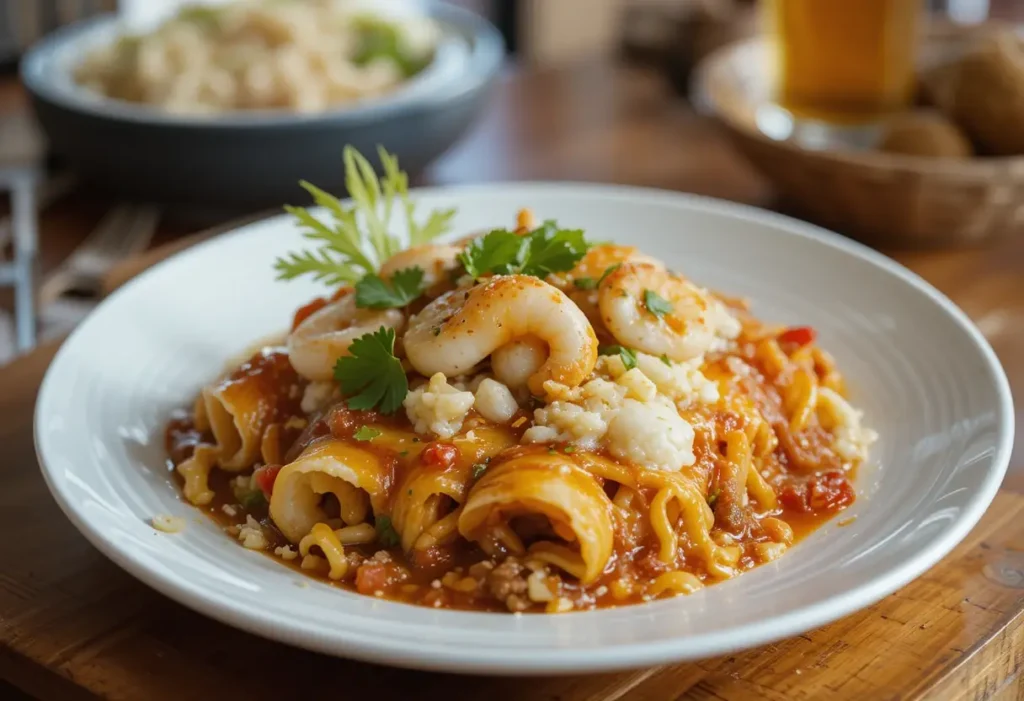
Storage and Reheating Tips
Proper storage and reheating ensure that your enchiladas retain their delicious flavors and textures even after the first serving.
How to Store Leftovers
- Refrigeration:
- Allow enchiladas to cool to room temperature before storing.
- Place them in an airtight container or cover the baking dish tightly with plastic wrap or foil.
- Store in the refrigerator for up to 3 days.
- Freezing:
- For longer storage, freeze the enchiladas before baking.
- Wrap each enchilada individually in plastic wrap, then place them in a freezer-safe container or zip-top bag.
- Freeze for up to 3 months.
- To freeze leftovers, cool completely, then follow the same wrapping process.
Best Practices for Reheating
- Reheating Refrigerated Enchiladas:
- Preheat the oven to 350°F (175°C).
- Place the enchiladas in a baking dish, cover with foil, and bake for 15-20 minutes until heated through.
- Add a small amount of extra sauce or cheese before reheating for added moisture.
- Reheating Frozen Enchiladas:
- Thaw overnight in the refrigerator.
- Follow the same reheating instructions as for refrigerated enchiladas.
- If reheating directly from frozen, bake covered for 30-40 minutes, then uncover and bake for an additional 10 minutes.
- Microwave Option:
- Place individual portions on a microwave-safe plate.
- Cover with a microwave-safe lid or damp paper towel to retain moisture.
- Heat on medium power for 2-3 minutes, checking halfway through.
With these variations and storage tips, you can enjoy seafood enchiladas tailored to your preferences while keeping them fresh for later enjoyment.
FAQs About Seafood Enchiladas
What seafood works best?
Shrimp, crab, white fish (like cod or tilapia), scallops, or lobster all work well. Mix them for more flavor and texture.
How can I make them gluten-free?
Use corn tortillas and replace regular flour with gluten-free flour or cornstarch. Check labels on canned and packaged ingredients.
What makes a creamy enchilada sauce?
Start with a roux, add heavy cream and broth, and sauté aromatics like garlic and chilies. Heat gently to avoid curdling.
Can I make seafood enchiladas ahead of time?
Yes! Assemble and refrigerate for 24 hours or freeze for up to 3 months. Bake just before serving for best results.
Any tortilla alternatives?
Try corn tortillas, zucchini slices, cabbage leaves, sweet potato rounds, or large lettuce leaves for gluten-free or low-carb options.
Conclusion
Mastering seafood enchiladas opens the door to countless culinary possibilities. Pairing your dish with other complementary recipes, like these Mini Chicken Pot Pies for an appetizer, creates a well-rounded meal. By exploring regional variations and following expert tips, you’ll bring restaurant-quality flavors to your table. Happy cooking!
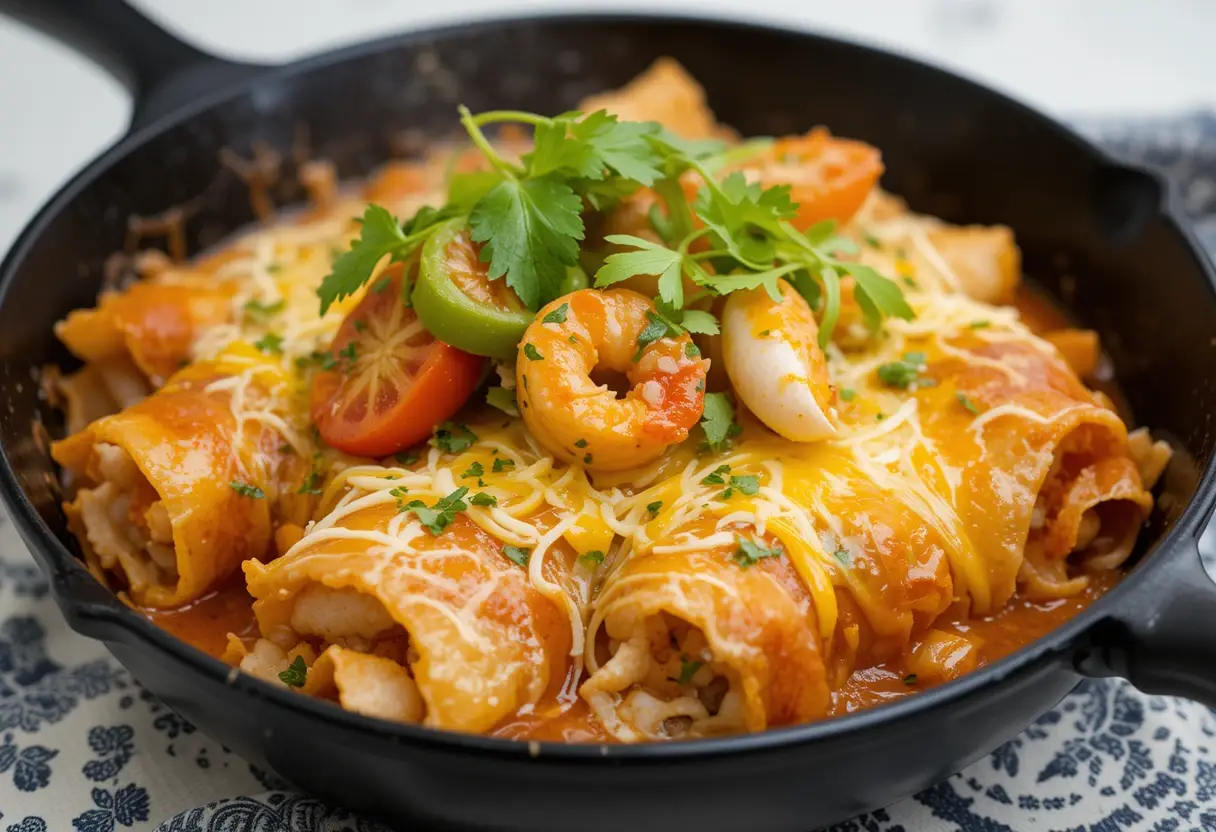
Seafood Enchiladas
Equipment
- Baking dish
- Mixing Bowl
- Saucepan
Ingredients
Seafood Filling
- 1 tbsp olive oil
- 1 cup shrimp cooked and chopped
- 1 cup crab meat imitation or real
- 1/2 cup onion finely chopped
- 1 clove garlic minced
Cheese Sauce
- 2 tbsp butter
- 2 tbsp flour
- 1 cup milk
- 1 cup cheddar cheese shredded
Assembly
- 6 flour tortillas medium size
- chopped cilantro for garnish
Instructions
- Preheat oven to 350°F (175°C).
- Heat olive oil in a pan, sauté onion and garlic until soft. Add shrimp and crab meat, cook for 2–3 minutes.
- In a saucepan, melt butter, whisk in flour and cook for 1 minute. Slowly add milk, stirring until thickened. Add cheese and stir until melted.
- Place seafood filling in tortillas, roll them up and place in a greased baking dish.
- Pour cheese sauce over enchiladas. Bake for 20–25 minutes until bubbly and golden.
- Garnish with chopped cilantro and serve warm.
